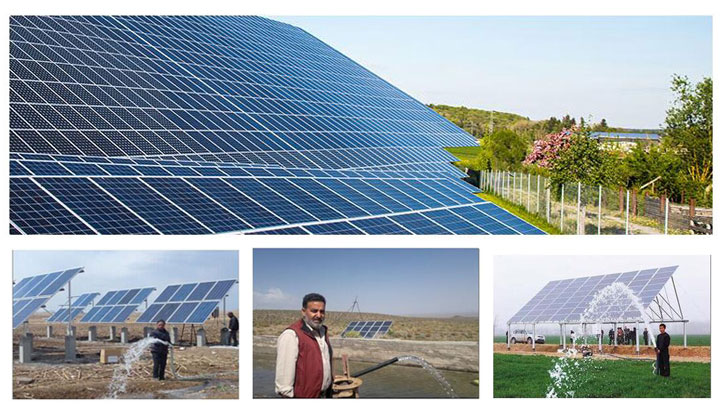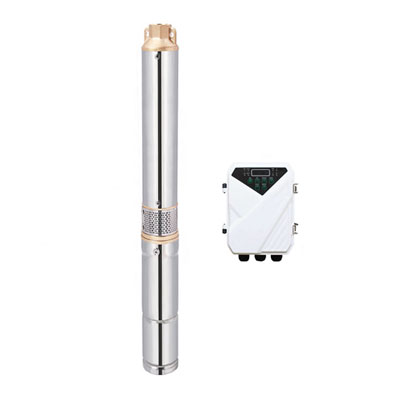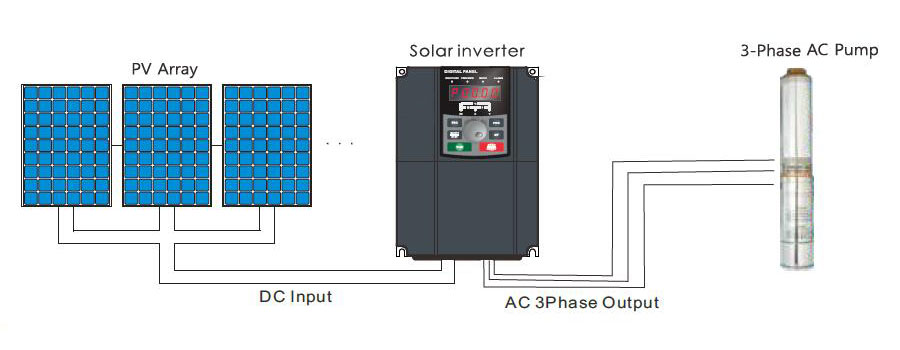Solar photovoltaic water pumping system, also known as photovoltaic water pump or solar water pump system, converts solar energy into electricity through solar cell modules and then drives the pump to raise water from low to high levels for farmland irrigation or human and livestock drinking. Solar water pump system projects can be built in areas rich in solar energy resources, making modular construction or staged construction according to the fund or industrial development, and realize automatic operation, costs low management fees.
Main components of solar water pump system
Three parts mainly constitute the solar pump system:
- Photovoltaic (PV) power generation part - photovoltaic module, which is the energy source of solar water pump
The photovoltaic module can convert solar radiation energy into electric energy. - Photovoltaic water pump control part - solar pump inverter
The inverter converts the electric energy from the DC to the AC by the inverter, and the solar water pump is driven to raise water by the inverter. - Water pumping machine part - solar water pump
There are additional facilities including pipes, machine rooms, reservoirs, and so on.
Construction conditions of solar water pumping system
- Have stable and reliable solar energy resources
The sunshine time throughout the year should be no less than 2200h, and the total solar radiation throughout the whole year should be no less than 1000k W.h/(m2.a). - Water source condition
The source's water quality and water supply should meet the corresponding standards and requirements. The water source should not be too far from the photovoltaic water pumping unit. The distance between the water pumping unit less than 2kW and the water source is not appropriate to exceed 10m, and the distance between the water pumping unit more than 2kW and the water source is not appropriate to exceed 20m.

Engineering design and construction of solar water pump system
1. Water source confirmation
The nature and water yield of the water source is an important basis for the construction and investment of the pump system. Pumps adopted by different water sources are very different. Generally, the water source is deep underground, so the submersible pump should be used. If the sediment content in the water is high, the sewage pump should be used. When good water inflow conditions exist, single-stage and multi-stage centrifugal pumps are used. One of the most important conditions for determining the source of water is that the water source does not dry during the dry season. The water level of the general pond varies relatively little, but it is necessary to confirm the lowest water level and water depth in drying. For deep wells, it is necessary to determine the depth of the well, the diameter of the well, the water level, the moving water level, and the water output. For rivers, it is required to determine the lowest water level in the dry season, the water depth, and the highest water level during the flood season.
2. Water consumption confirmation
The water consumption standard of human and livestock drinking water and crop irrigation water should be determined according to the actual situation. It must meet the current needs, not waste, but also consider the needs of recent development, and most importantly, it must behave according to the fund condition.
3. Solar water pump selection
The pump should meet the requirements of system lift and flow. Centrifugal pumps (including various self-priming pumps, pipeline pumps submersible pumps, and so on) are suitable for being used as solar water pump, which has a high efficiency, cheap price, and minimum future operation and maintenance cost. As long as the lift and flow are met, this is the first water pump type. The second type is the positive displacement pump (including a piston pump, a reciprocating pump, and so on). This type of pump has the characteristics of the highest efficiency and the highest lift. The maximum lift can exceed several kilometers. It is especially suitable for being used on occasions with high lift and small flow. However, it has the disadvantages of high price, big size, heavyweight, and insufficient future exchange cost. Larger PV pump systems use double pump or multiple pump systems wherever possible.
4. PV module selection and the square array site construction
The photovoltaic array is the power core of the entire system. The model selection and configuration of the photovoltaic module are the main factors determining the cost performance of the photovoltaic module system. According to the light intensity temperature characteristics of the solar cell and the performance evolution characteristics of the life cycle, it is a rather reasonable configuration for the capacity of the general photovoltaic module being 1.3 to 1.6 times larger than the power required by the pump motor. The specific value must be determined according to the lift and the pump model selection. The photovoltaic array needs to be installed in a place with a stable foundation is stable and good sunshine. Photovoltaic subarray layout should minimize land occupation according to terrain but must meet the standard of independent photovoltaic power plant technical specification.
5. Solar pump inverter selection
The solar water pump is not like the pump powered by the conventional AC grid. Because the electricity generated by the photovoltaic module is the direct current, it is required to invert the direct current into a three-phase alternating current for being used by the water pump through the inverter. Then, the solar pump inverter special for PV water pumps should be selected with high reliability and high system efficiency. The capacity of the solar pump inverter must meet the heavy-duty startup of the selected pump. If it is used in the highland area, the capacity reduction caused by the high altitude must be taken into account, so to ensure the long-term and reliable operation of the system. In normal conditions, the power of the PV pump inverter is required to be one stage higher than that of the water pump motor.

6. Pipeline design
The general photovoltaic pump can be considered to operate for 5h on sunny days at full power. The piping design must be able to meet the flow requirements. The general pipeline resistance should be no more than 5%. In addition, it is required to pay attention to the pressure resistance of the pipeline. The general galvanized pipe can only withstand pressure of 10 to 15 kg, so the seamless steel pipe should be adopted.
7. Reservoir design
For the project of human and animal drinking water, the volume of the high-level pool should be able to meet the daily water yield of at least 3 to 5 days, and the elevation must meet the requirements of being able to flow to all families. For crop irrigation water, the larger the pool volume, the better. For example, if it is required to water for one to two months in a dry period of one year, and the equipment is not used in the rest time, it is suggested to pump water in the reservoir 3 to 5 months in advance. The reservoir used for irrigation water has no high requirement. The reinforced concrete pool is not a must. Some water pools and ponds can be used as long as they do not leak water. When the terrain is a relatively steep slope, one pool or several pools can be built on the half slope where there are more irrigating lands. The dispersed construction of the pool can also reduce investment and, more importantly, avoid damage caused by landslides due to the heavy weight of the large pool. The place with the pool is built must have a stable geological structure and can withstand the weight of the pool after water storage.
Inverter.com sells solar water pumps from 80W to 1500W, please feel free to contact us if you need it.
